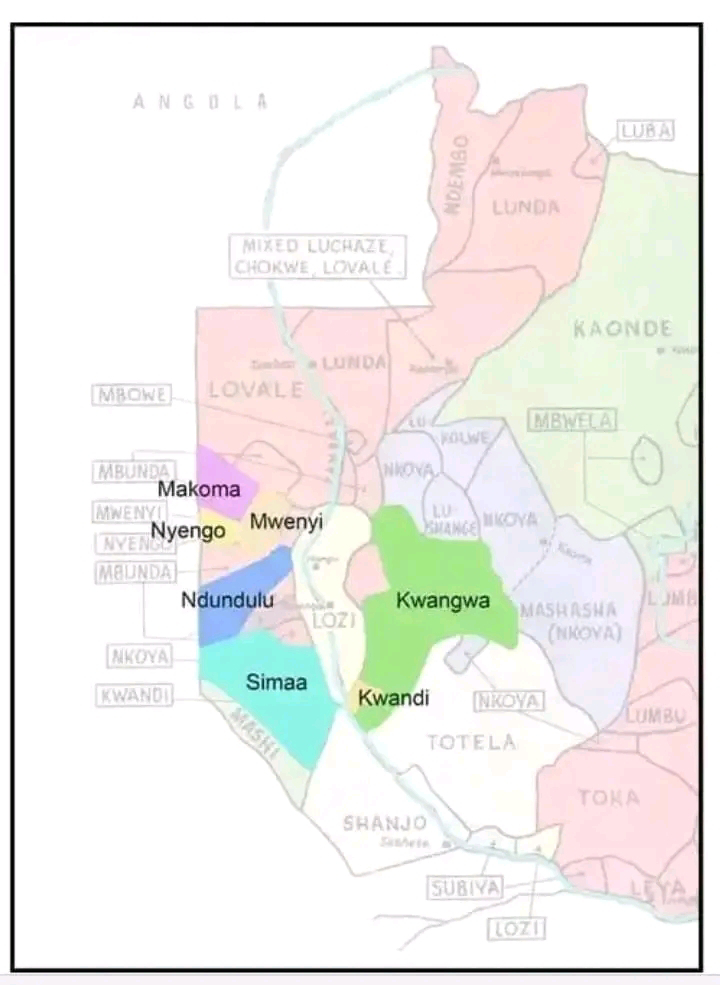THE HISTORY OF THE KWANGWA PEOPLE
The Kwangwas are an offshoot of the Luyi people. The Luyi people arrived around Mongu on the Barotse Floodplain in the mid-1600s under the leadership of a woman named Mwambwa. Mwambwa’s daughter took over the leadership but she abudicated the thrown to her son Mboo, who took charge.
It was during Mboo’s reign that two of his relatives, Mange and Mwanabinyi, went out to form their own chieftainships. Mwanabinyi went south to form his own clan named Kwandi; he took over land then occupied by the Subiya and Mbukushu. (The Subiya are still part of the tribal make-up of Zambia, but the Mbukushu are now mainly present in the Caprivi and northern Botswana). Mange went east and formed the Kwangwa people; he occupied land which was then used by the Nkoya. The Nkoyas who were prized good hunters went further east and settled in the place called Upa Ngoma, present day Kaoma.
For over a hundred years, while Mboo and his descendants continued to expand the Luyi empire, the Kwangwa and Kwandi people grew and prospered. There were, at the time, few outside threats to their lives. The Kwangwa had no chief after Mange, but came under the chief of the Luyi, paying tribute.
In the 1830s things were to change. The Kololo arrived and took over the large empire that the Luyi had built up over the years. The Kololo, a southern African tribe had left their original homes because of the warring Zulus.
It took 4 years of fighting between the Kololo and Luyi before the Kololo managed to subdue the people of the land. No doubt the Kwangwa were involved but we have no record.
With regard to their name "Kwangwa", it was given to them after the mysterious disappearance of their leader Mange. They failed to defend him during a war, thus, we are told that he submerged in lake Makapaela. From then onwards, they were called akangwa Mange, or those who failed Mange. The name was shortened to " Kwangwa" , meaning failures, and it was attributed not only to Mange's followers but all the Aluyi who migrated to the upland instead of staying in the plain. They failed to dwell in the place Nyambe found for them. That's why today kwangwas are the most populous tribe on Bulozi. Most are the Luyis who chose the upland. During that time many of the ruling Luyi clan, their supporters and allies fled. There were several groups but many Kwangwa left for the north to a place known as Lukwakwa.
However, once the chief of the Kololo had taken control he proved to be a worthy ruler and peace largely reigned in the empire. It wasn’t until the chief died in 1851, 12 years later, that tensions began in the realm. The next chief was unworthy (Mbololo) of his position and killed many of the people. Finally, the Luyi resolved to take back their empire.
The Kwangwa supported their own nominee, Mbua, but they failed to oust the Kololo. Instead, another group headed by Njekwa, was successful. Njekwa was unwilling to take on the chieftainship and Sipopa Lutangu became chief. Sipopa had stayed at Mongu under the Kololo, but he was a true descendant of the original chiefs of the Luyi. Sipopa was to reign for the next 12 years until he was killed in another coup. Sipopa, during his time dealt severely with any supporters, including the Kwangwa, who had challenged his claim to the throne. Many more Kwangwa fled north to Lukwakwa.
During the time of the Kololo, the Kololo language (Sotho) had become the lingua franca of the realm. The Kwangwa, however, maintained their version of the Luyi language.
It was at the end of Kololo rule that the Luyi people became known as the Lozi. The Lozi had a hierarchical system for their tributary tribes. Accordingly, the Kwangwa and Kwandi are considered proto Lozi i.e. proper Lozi.
The Kwangwa were known for their skills as blacksmiths, smelting their own iron ore and making tools and spears, like their neighbours, the Totela. As the Totela were the original inhabitants of the area, we can probably assume that the Kwangwa learnt the art from them thanks you.
References: Dictionary of African Historical Biography.
(3).png)


